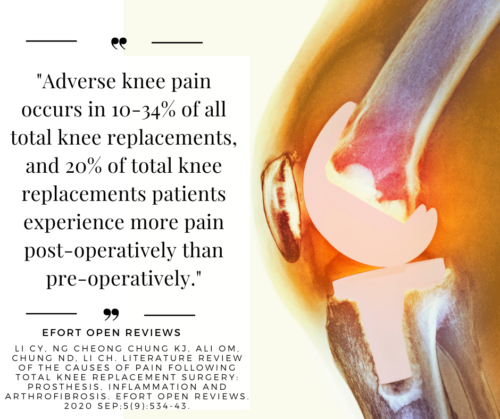
Knee Replacement Failure Statistics
Knee replacement is a huge undertaking. The surgery requires hospitalization and prolonged downtime. But is this surgery just a one-time thing? Unfortunately, it may not be!
Additionally, there is also a risk of replacement failure necessitating revision surgery down the road. How high is that risk?
The leading cause of knee replacement failure is infection. Instability, looseness, persistent stiffness, ongoing pain, and metal allergies are additional reasons for failure.
Revision Surgery
When replacements fail, revision surgery is needed, and revision surgeries have even worse outcomes than the initial replacement. (1)
Higher Recipient Rates
One reason failure rates are getting higher is that more people are getting knee replacements. People are receiving knee replacements at a younger age too. And knee replacements don’t last forever. In time, all knee replacements fail.
Continued Pain after Knee Replacement
Knee replacement recipients report a substantial rate of continued pain after knee replacement. Twenty percent or one in five patients who undergo total knee replacement for osteoarthritis report an unfavorable pain outcome after surgery. (2)
German physicians reported even higher rates of pain, “About one-third of all patients after total knee arthroplasty experience persistent or recurring pain and/or dissatisfaction.”(3)
And researchers from the United Kingdom reported that “adverse knee pain occurs in 10-34% of all total knee replacements, and 20% of total knee replacements patients experience more pain post-operatively than pre-operatively.”(4)
Results vary when data is reviewed to show how long knee replacements last. Some studies show 15 years, others 20 years, and still others 25 years. (2,5,6)
You may be surprised that your idea of success and the surgeon’s idea of surgical success may differ completely. The surgeon may be satisfied that the surgery itself went well. But you may not be happy with that alone. If you have pain, a loose knee, swelling, and less walking ability after surgery than before, you may not feel like the surgery was a success.
In the Journal of Arthroplasty, researchers described patient dissatisfaction with their knee replacement due to looseness. The patients reported more pain and unmet expectations. (7)
Patients generally expect a better quality of life after surgery, including less pain and an increased ability to do the activities they want. When these expectations are not met, patients are dissatisfied.
Regenerative Orthopedics is an alternative therapy that can be sought before surgery. The treatment should also be sought if surgery has already been done, and the patient is dissatisfied, or if the pain continues.
Before getting to the point of surgery, these regenerative treatments can stop the cycle of degeneration, reduce pain, and improve function. Osteoarthritis is the main reason people end up facing a knee replacement. Arthritis occurs because of instability in the knee joint. The instability is the result of an old or new injury. Regenerative Orthopedics can stabilize the knee and stop the degenerative process in these cases.
Regenerative treatments can also help once a replacement has been done. The connective tissues damaged by the surgery or the damage due to the new stress placed on them by the implant can be strengthened and repaired.
We are pleased to offer this alternative to knee replacement and a solution when pain and dissatisfaction continue after knee replacement. Give us a call at 310-453-1234.
(1) Agarwal, Sanjeev, et al. “Why are revision knee replacements failing?.” The Knee 26.3 (2019): 774-778.
(2) Beswick AD, Wylde V, Gooberman-Hill R, et al. What proportion of patients report long-term pain after total hip or knee replacement for osteoarthritis? A systematic review of prospective studies in unselected patients. BMJ Open 2012; 2:e000435. doi: 10.1136/bmjopen-2011-000435
(3) Mathis DT, Hirschmann MT. Trotz Knietotalprothese schmerzt das Knie – was nun? [Painful knee after total knee arthroplasty – what can be done?]. Ther Umsch. 2020;77(10):491-497. German.
(4) Li CY, Ng Cheong Chung KJ, Ali OM, Chung ND, Li CH. Literature review of the causes of pain following total knee replacement surgery: prosthesis, inflammation and arthrofibrosis. EFORT Open Reviews. 2020 Sep;5(9):534-43.
(5) P van der List, DL Sheng, LJ Kleeblad, H Chawla, AD Pearle. Outcomes of cementless unicompartmental and total knee arthroplasty: a systematic review. Knee, 24 (2017), pp. 497-507.
(6) T Niinimaki, A Eskelinen, K Makela, P Ohtonen, A-P Puhto, V Remes. Unicompartmental knee arthroplasty survivorship is lower than TKA survivorship: a 27-year Finnish registry study. Clin Orthop Relat Res, 472 (2014), pp. 1496-1501.
(7) Broberg JS, Naudie DD, Lanting BA, Howard JL, Vasarhelyi EM, Teeter MG. Patient and Implant Performance of Satisfied and Dissatisfied Total Knee Arthroplasty Patients. The Journal of Arthroplasty. 2022 Jun 1;37(6):S98-104.